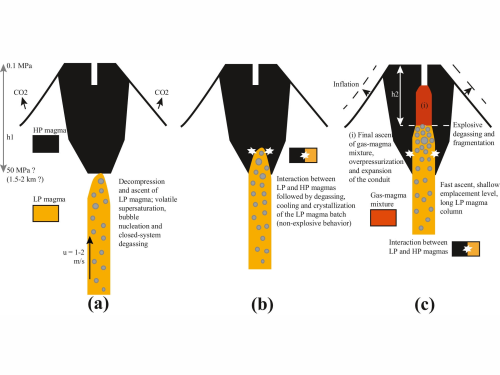Timescales and mechanisms of paroxysm initiation at Stromboli volcano, Aeolian Islands, Italy

Pichavant M., I. Di Carlo, M. Pompilio & N. Le Gall.
Bulletin of Volcanology, 84, https://doi.org/10.1007/s00445-022-01545-9
Abstract
New textural and petrological data are presented on products from five paroxysms at Stromboli (Aeolian Islands, Italy) including the two from 2019 and three historical (1930, undated, sixteenth century) eruptions. The data are used to constrain timescales associated with the initiation of paroxysms and to examine current models for their triggering. Samples were collected from the deposits and a subset selected for mineral separation and petrological and textural characterization. Minerals and glass were imaged by scanning electron microscopy (SEM), and chemical composition and zonation were analysed by electron microprobe. Trace elements in olivine were also determined. Vesicle number densities, vesicularities and vesicle diameters were measured by X-ray microCT techniques. The data were systematically compared with results of experiments simulating, on the one hand, ascent, vesiculation, degassing and crystallization of LP (low-porphyricity) magma and, on the other hand, interaction between LP and HP (high-porphyricity) magma. Paroxysm samples are mixed and include portions representative of both LP and HP magma. They host in variable proportions minerals and glass texturally and compositionally typical of these two magma types. Small but systematic variations in matrix glass compositions are found between each of the five eruptions considered. All samples host a population of vesicles ranging from < 15 to > 1000 μm in diameter and whose size distributions follow mixed exponential to power law distributions. Vesicularities are high (75% on average) and vesicle number densities range from 102-103 to 103-104 mm-3. Using experimental calibrations, the vesicle textural data suggest average LP magma ascent rates of 1–2 m/s (i.e. ~1.5 hours from depths between 7 and 1.5 km). The correlation between ascent rate and textures demonstrates systematic variations between eruptions, the most energetic (i.e. that of 1930) being associated with the highest ascent rate (~2 m/s). Widths of plagioclase reaction zones indicate that LP and HP magmas interacted for a maximum a few hours before eruption. Olivine reaction also implies durations of a few hours for LP-HP interaction and is followed by crystallization for 20 hours in the HP magma. Our results stress the fast ascent of LP magma from their storage region and their short residence times at shallow levels before being erupted. They clarify the respective roles of the deep and shallow feeding systems. An integrated phenomenological model for paroxysm initiation at Stromboli is outlined.


Devi effettuare l'accesso per postare un commento.